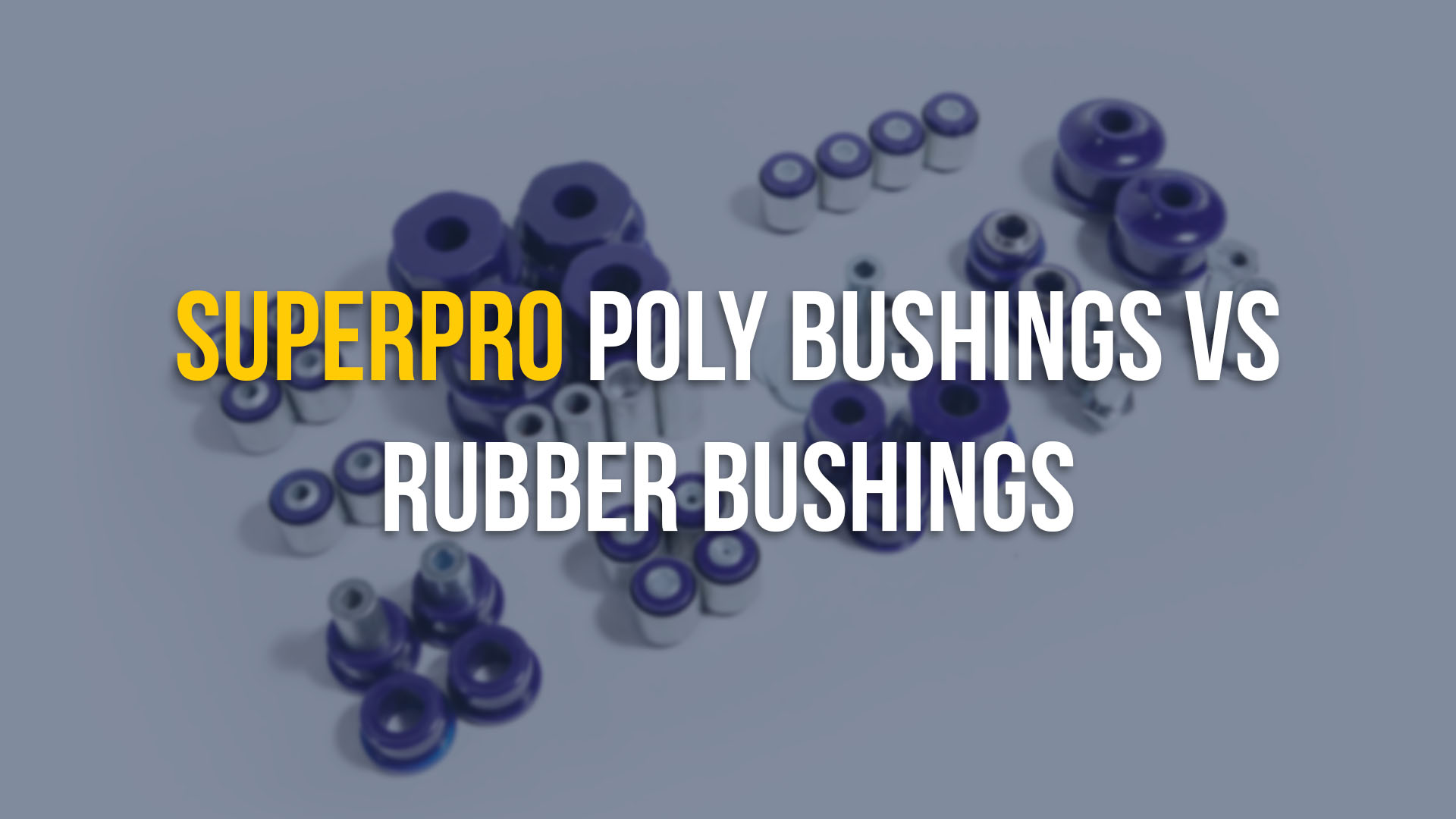Which is best a Rubber bushing or SuperPro Poly Bushing?
The purpose of this write up is to clear up the misconceptions that surround both polyurethane bushings and rubber bushings. Specifically looking at the use of rubber bushings in standard and aftermarket applications compared to SuperPro polyurethane bushings.
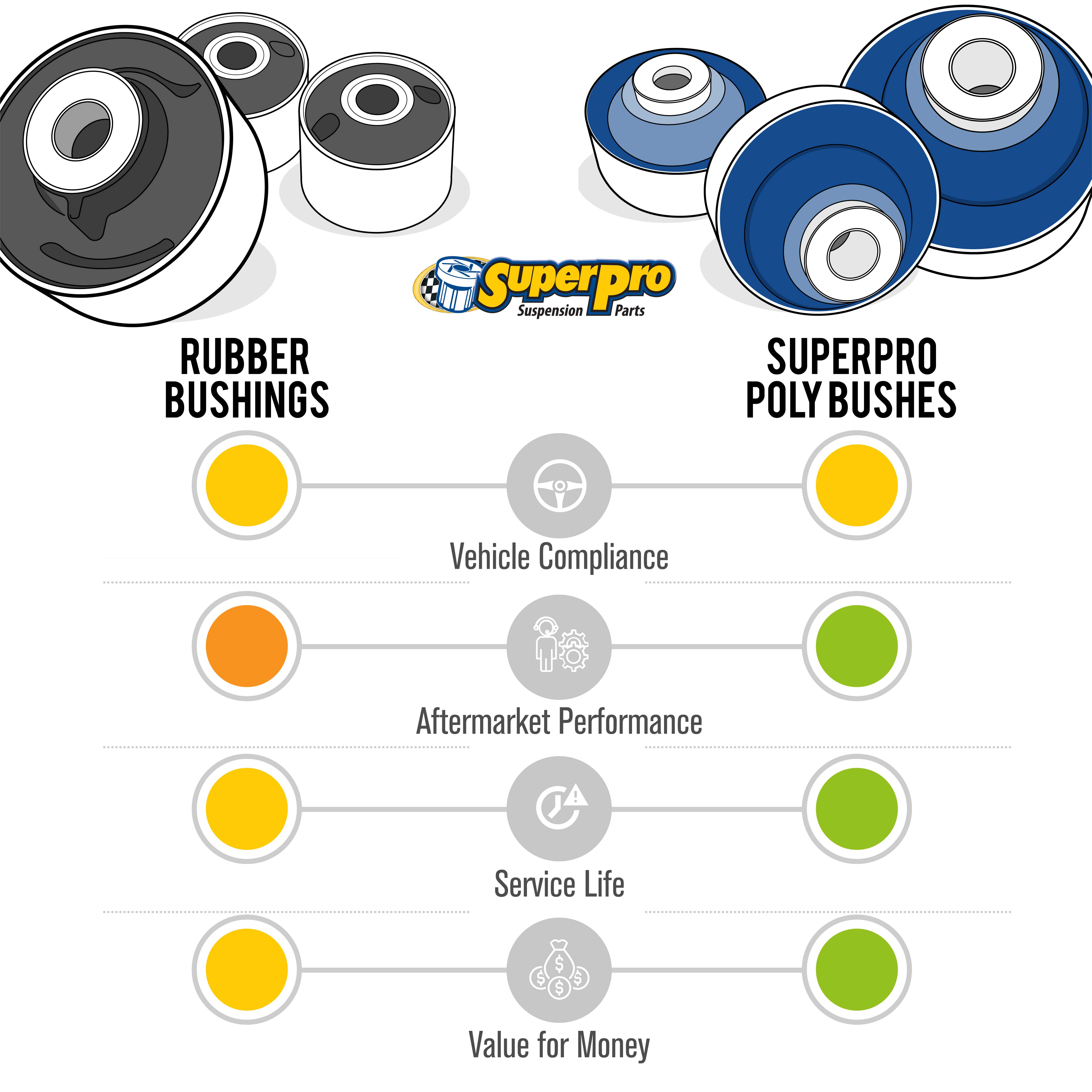
Poly vs Rubber Bushing Considerations
Below are some considerations and comparisons to be made.
Overview: Polyurethane bushings are superior to rubber bushings. SuperPro is one of the largest polyurethane bushing manufacturers in the world. SuperPro bushings are specifically designed for each application and include proprietary design and material features, unique only to SuperPro. No polyurethane bushing is made equally, all normal design flaws generalised and associated with poly bushings are non existent in SuperPro bushings.
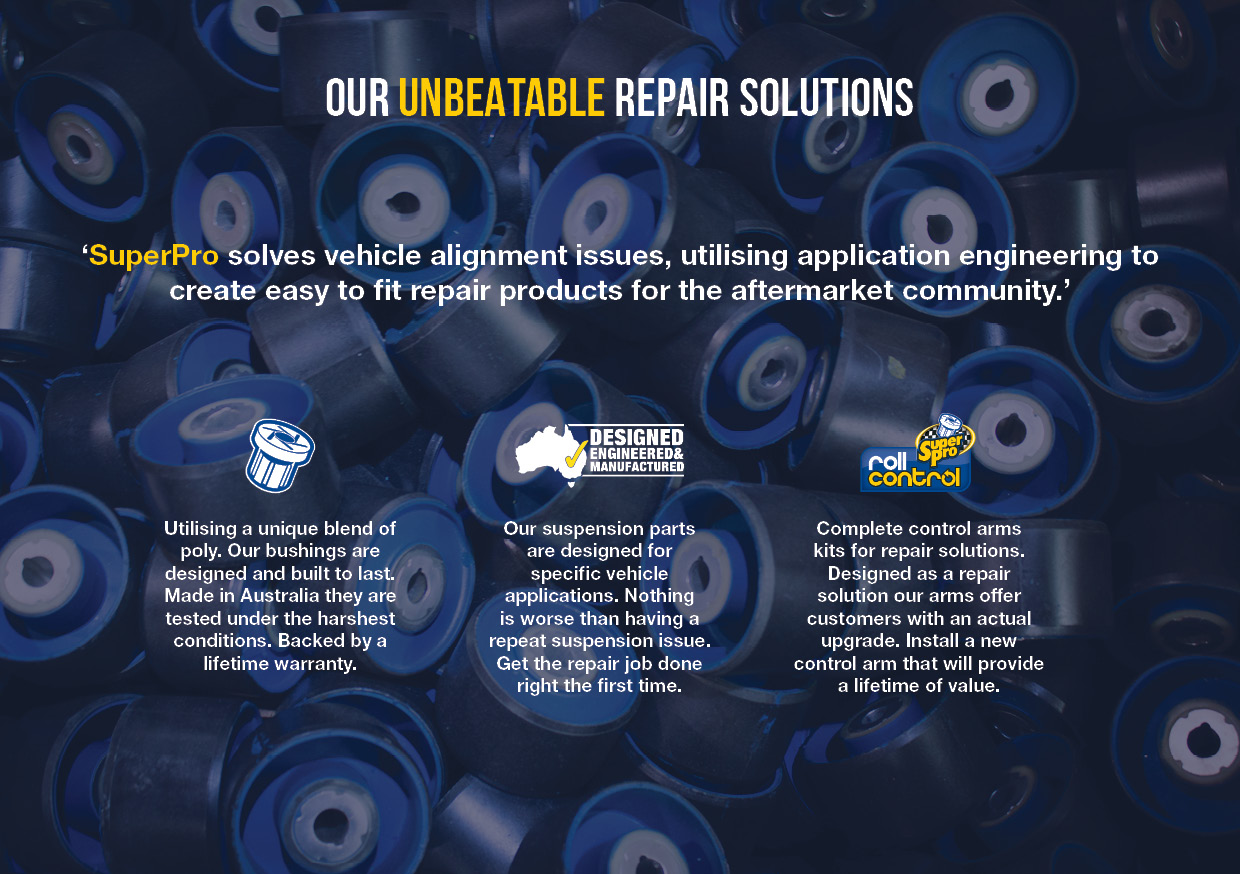
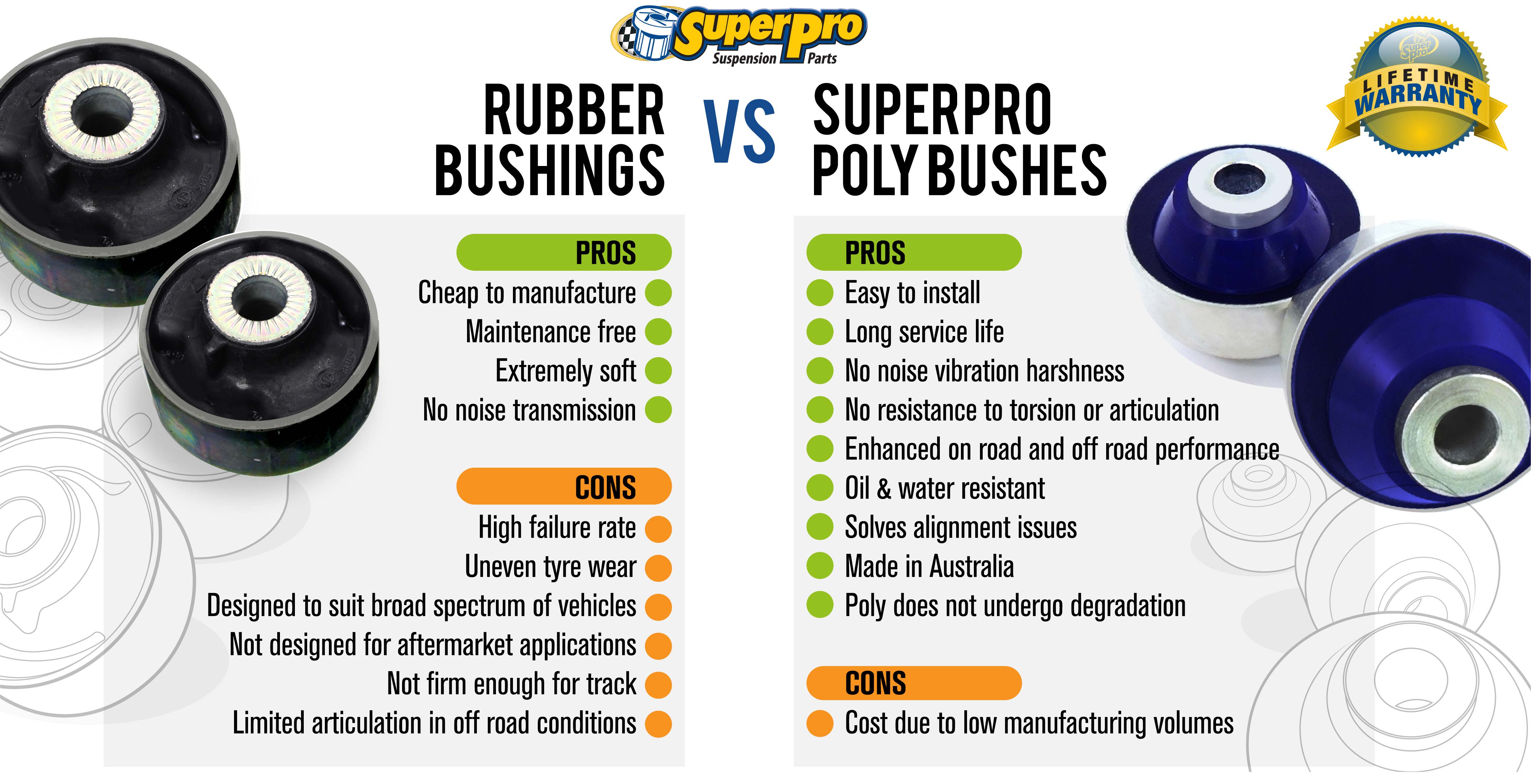
Bushing Material and History
Rubber bushings and Polyurethane bushings each have a unique history, and each have a very specific use in the automotive industry.
Rubber Bushings
Nearly all OEM manufacturers use rubber bushings but there are also a few aftermarket rubber bushing manufacturers. Rubber bushings came about in the 1950s and were seen as a marked improvement over the original metal components that required frequent maintenance and replacement due to extensive wear.
Rubber is made of either a synthetic or naturally made material that in its natural form is an elastomer or polymer made up of many monomers. You may be surprised to learn that natural rubber actually accounts for less than 35% of all production of rubber. The other 65% of rubber production is synthetic. Synthetic rubber is made from petroleum by product monomers that are combined with other monomers (in various configurations) that result in a wide range of properties.
Rubber is easily accessible and lower in cost; many OE manufacturers prefer this to keep costs of production lower. Tooling is also cheaper for rubber bushings, making mass production a cost-effective solution for vehicle manufacturers. Rubber bushings under a load tend to flex, stretch, and compress. This can transfer into your steering, causing some difficulties with traction and creating oversteer or understeer. Rubber bushings when manufactured by OEM are reliable for basic applications such as everyday driving but aftermarket rubber bushings are not. Rubber bushings no matter the manufacturer will always have design flaws due to its material make up.
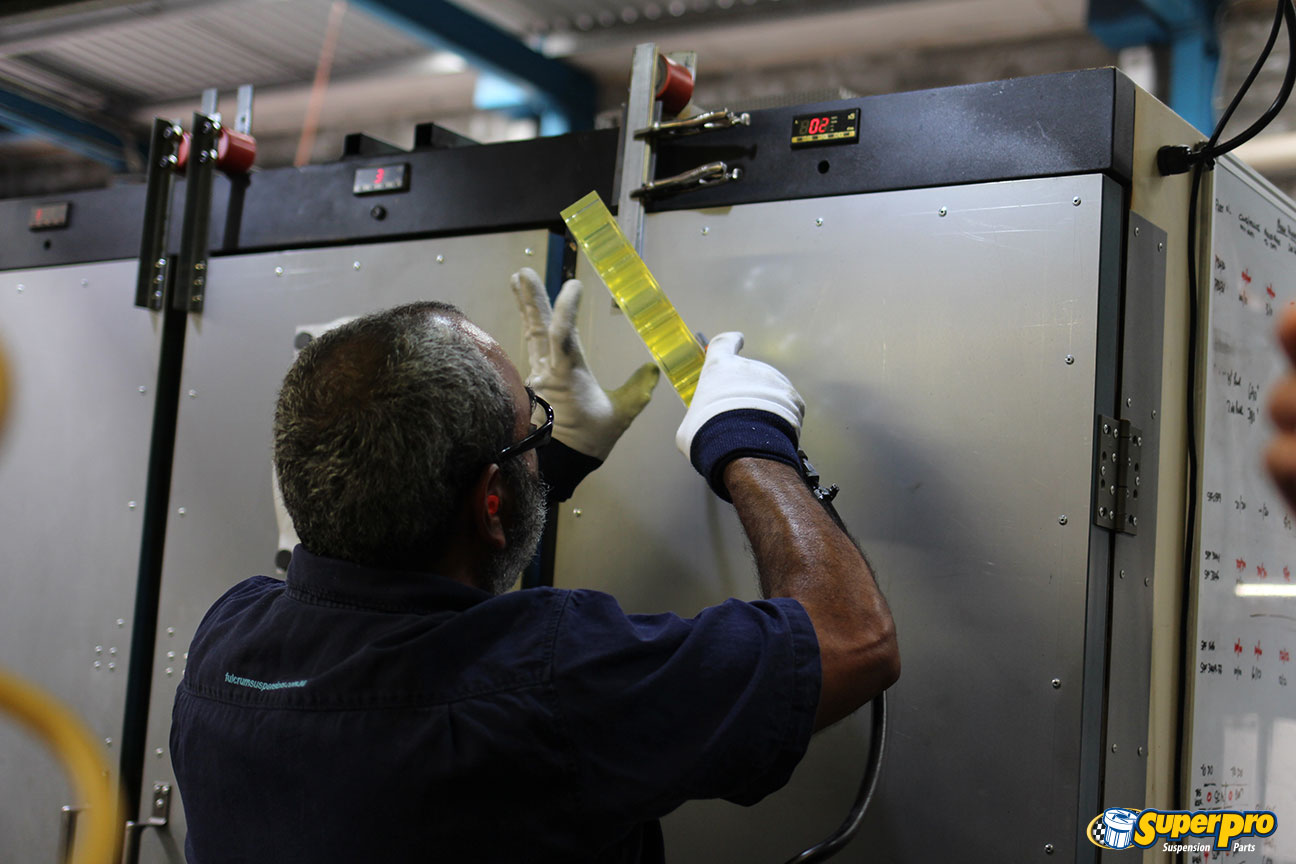
SuperPro Polyurethane Bushings
Poly bushings are the relatively new kid on the block in comparison to the broader history of the automotive aftermarket industry. There are very few poly bushing manufacturers that create a decent bushing using material, engineering and manufacturing to create the perfect suspension bushing. That is why it is so important you find a suspension manufacturer that knows what they are doing.
Due to the unique material properties Polyurethane has to offer, better bushing designs and material blends can be made to suit specific vehicle applications. SuperPro Suspension, prides itself on application engineering, creating a bushing meant to be used for a specific vehicle and purpose. Allowing for better vehicle traction, alignment and durability on and off road.
Invented in the 30’s - Polyurethane was adopted during World War II to replace rubber in many applications due to its superior performance and the scarcity of rubber raw materials. Post war the technology was further developed including for use by NASA.
Because Polyurethane is such a unique material, it can be manipulated to maintain many different properties. When poly is correctly blended you can produce the perfect bushing material.
Traditionally polyurethane has been associated with being a hard material, giving excessive NVH (Noise, vibration, and harshness). While the cost of buying some brands of poly bushes may be significantly more than a rubber bush, if designed correctly for its application. A poly bushing can save you money in the long run with a long service life and performance that doesn't degrade over time.
Hear what SuperPro Lead Engineer Kirk has to say about Rubber vs Poly bushing Material & History.
Ride Quality
Rubber Bushings
Soft and Doey is the best description you can give a rubber bushing. If you drive any modern vehicle you will find that the car is wonderfully quiet and soft. Sadly, this doesn't transmit into having a vehicle that handles, accelerates and brakes well. The longevity of a rubber bushing is also a factor in ride quality as rubber bushings are built to fail, your ride quality will decrease over the service life of a vehicle.
Rubber bushings in aftermarket conditions are perform at a lower standard and have a shorter lifespan when compared to SuperPro bushings. Mainly due to rubber breaking down easily when in contact with dirt, oil and water. The second issue is that rubber bushings are not designed to handle the amount of increased flex and torsion movement required when driving on track and off road.
Rubber bushings are able to compress into themselves; this is great for comfort but not good for the wear of the material. The more a rubber bushing flexes, the more micro tears form in the bushing and bring it closer and closer to failure.
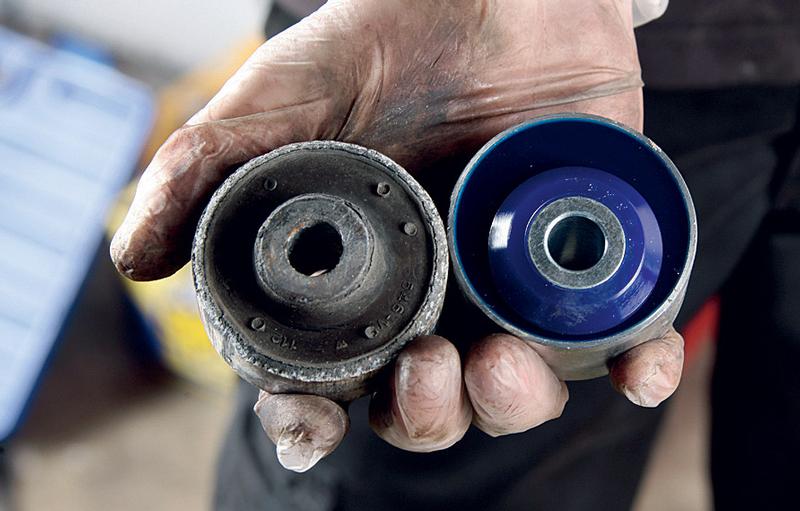
SuperPro Polyurethane Bushings
SuperPro poly bushings offer a firm ride, yet still supply a comfortable driving experience through a responsive drive. Due to SuperPro bushing design features, there will be no increased noise, vibration or harshness (NVH). If you’re looking for better driving performance, direct steering, long service life, sharper and more responsive handling, then SuperPro poly bushings are the best solution.
SuperPro polyurethane bushings in off road conditions do not suffer, firstly because they are designed to suit the vehicles application. They also outperform in off road conditions to the materials ability to flex and rotate.
Poly bushings act as an incomprehensible liquid, the bushing has to be able to move and flex whilst maintaining shape. SuperPro design features actually control the movement of the bushing. When the bushing comes under load, it will flex and allow movement which is why there is no breakdown in ride quality. However, when extreme forces are applied to the bushing, the bushing is forced to stop moving, that is why you get a firmness in the vehicle when driving. This firmness is what offers increased responsiveness and handling. So SuperPro poly bushings offer both flexibility and also the firmness to offer direct alignment and handling improvements.
Hear what SuperPro Lead Engineer Kirk has to say about Rubber vs Poly bushing Ride Quality.
Engineering and Manufacturing
Rubber Bushings
Rubber bushings are produced on a massive scale, there is still a lot of engineering that goes into a rubber bushing. The main goal for rubber bushings is to keep the price down. But comparing it to a poly bushing rubber bushes are generally mass produced without application specification as they are built to suit 99% of the world’s drivers. The main goal of a rubber bushing is to ensure maximum comfort, and this is done by creating an extremely soft bushing. The caveat to this is that the due to the rubber bushings material makeup and the way it is being manufactured, this soft engineering process actually acts as a negative. Causing a short life span, poor tyre wear, vehicle shudders and alignment issues.
Manufactured in mass cavity presses, invested heavily in tooling for mass production. Low cost because of mass production.
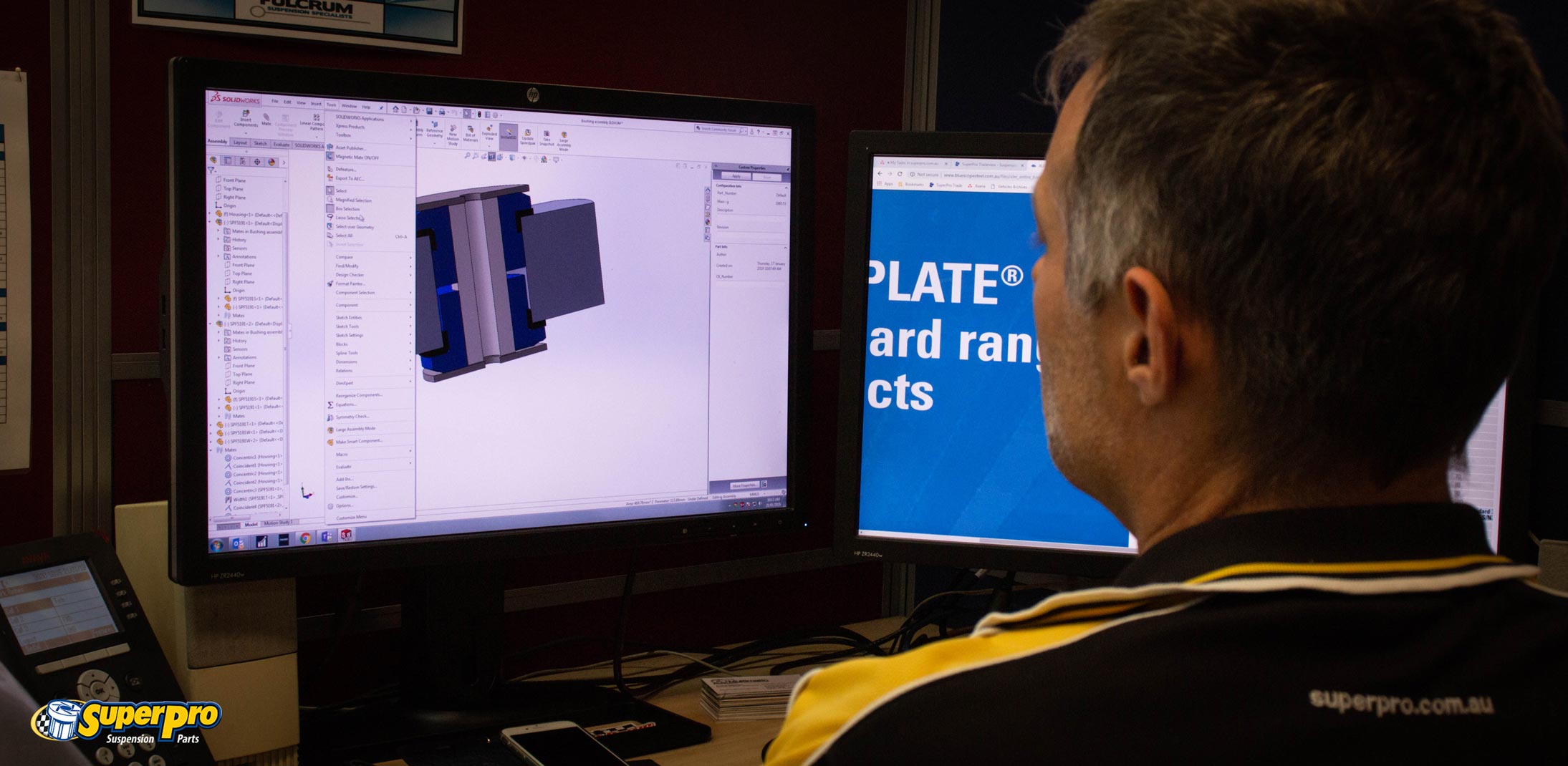
SuperPro Polyurethane Bushings
A lot more time, effort and thinking goes into a polyurethane bushing, especially a SuperPro poly bushing. Due to the complexity of material and also the manufacturing process behind a SuperPro Poly bushing. The material design must be perfect in order to supply a bushing which will perform in all conditions. SuperPro bushes are designed to fit an exact parameter of housing dimensions.
SuperPro basically takes an OE bushing and analyses it completely to see what they can do to make it the best possible suspension bushing. This includes adding design features for fitment, long service life and correct alignment issues not addressed by rubber bushings.
SuperPro poly bushes are designed and manufactured in Australia. SuperPro bushings have a hands-on manufacturing process, ensuring constant QA of their product.
Hear what SuperPro Lead Engineer Kirk has to say about Rubber vs Poly bushing Engineering & Manufacturing.
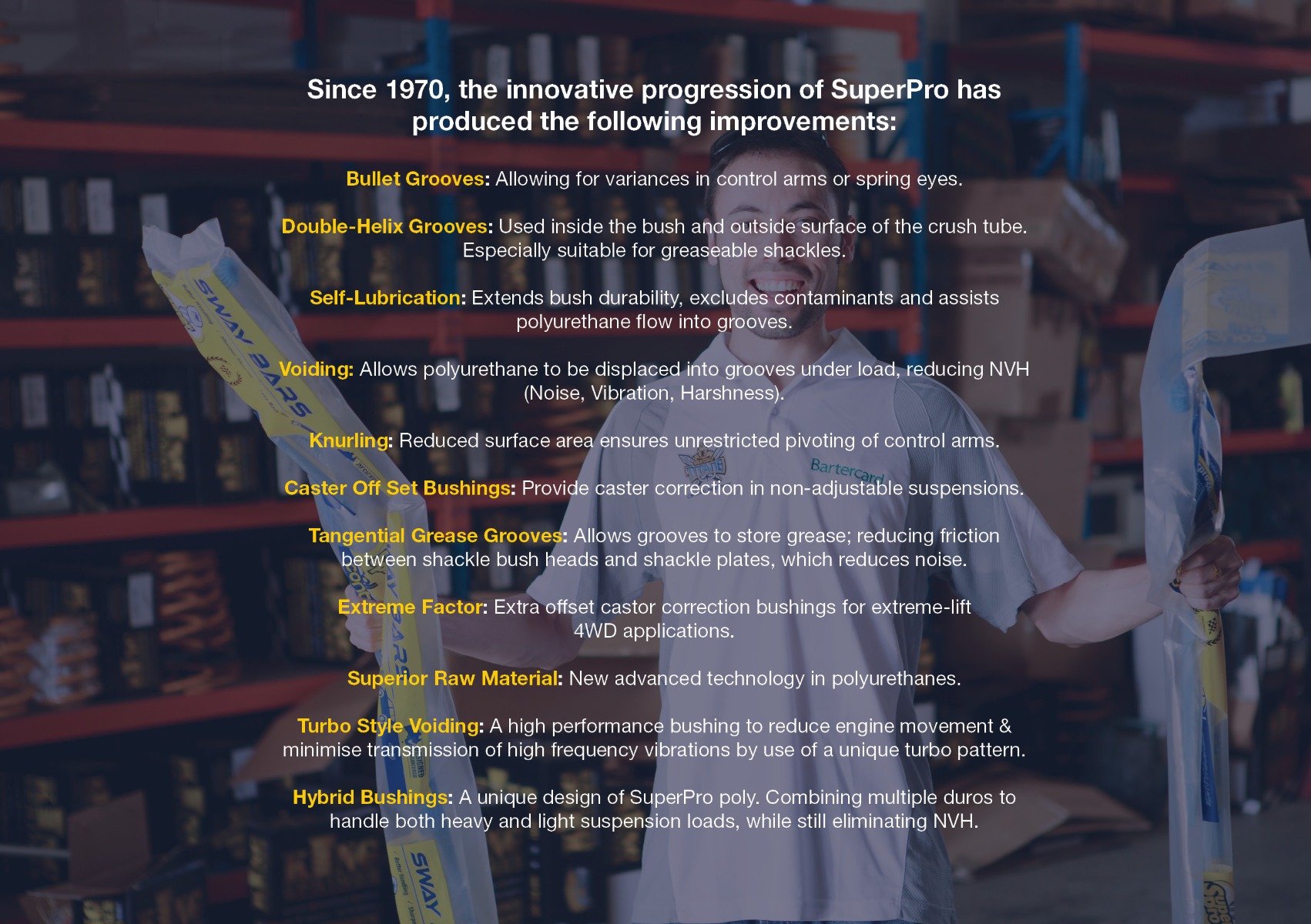
Service Life
Rubber Bushings
Rubber bushings have a low service life due to material degradation and micro tears caused due to the pivoting action of the vehicle’s suspension. As soon as the car starts driving with a rubber bushing, the rubber bushing begins to fail.
SuperPro Polyurethane Bushings
SuperPro bushings on the other hand are design to last a lifetime. Rubber bushings are analysed and then an alternative SuperPro poly bushing is designed to offer a great service life. SuperPro guarantees the value of their bushings with a lifetime warranty.
Poly bushings offer a lifetime of value, they are largely maintenance free. SuperPro provides grease to all bushing kits, purely for installation and assembly of the bushing.
Regular greasing is not required for SuperPro bushings as the surface of SuperPro poly is naturally slippery. The installation grease supplied is easily embedded into the surface of the SuperPro poly bushing and it will maintain contact with the bushing throughout the complete lifetime of the bushing.
Hear what SuperPro Lead Engineer Kirk has to say about Rubber vs Poly bushing Service Life.
Noise Level (NVH)
Rubber Bushings
Rubber bushings are largely silent unless they are overloaded or have failed.
SuperPro Polyurethane Bushings
SuperPro poly bushings are designed to not transmit any NVH (noise vibration harshness).
Hear what SuperPro Lead Engineer Kirk has to say about Rubber vs Poly bushing Noise Level.
Installation
Rubber Bushings
Rubber bushings require a lot of tension force for installation, usually requiring much trickier setups.
SuperPro Polyurethane Bushings
SuperPro bushing kits, often do not require a shell due to the strength of the material make up. If a bushing shell is required than the size of the shell usually dramatically mitigated. These design changes offer a much easier installation but better fitment.
Hear what SuperPro Lead Engineer Kirk has to say about Rubber vs Poly bushing Installation.
The most common complaint surrounding polyurethane is that it is too hard and causes unwanted Noise, Vibration & Harshness (NVH). This will have your customer back complaining quicker than anything else! But, rubber has its own drawbacks, lesser service life, excessive movement in the suspension arms, distortion due to the voiding and lack of memory. Also, rubber really doesn’t like oil, petrol or coolant and that’s a real downer for an automotive part.
The other key point here is that rubber bushes are not always available on their own. Often an assembly is all you can get from the dealer meaning you have to replace the whole arm or assembly even through just one bush has failed. This is a positive for many aftermarket bushes and the polyurethane guys have this angle covered particularly well.
Anyone can make a polyurethane bushing and a few manufacturers make very good ones. polyurethane is name given to broad range of products from hard plastics to carpet underlay. polyurethane Manufacturers who develop their formulation for use as suspension bushing from the outset are ones who understand the concept of developing a higher quality, quiet, longer lasting and superior alternative to rubber.
Polyurethane from these manufacturers has superior mechanical properties, superior abrasion resistance, excellent memory properties and are largely unaffected by temperature, oils and coolant. This makes this type of polyurethane bushing a cost-effective and viable alternative to rubber bushings, without the worry of NVH.
In some applications polyurethane is the only alternative. We have all seen the new style of vertical pivoting bushing (VPB) that is starting to appear more and more. Typical examples of this would be Toyota Camry front lower control arm and the newer vehicles from Europe and Korea. This style of bushing was aimed at increased efficiency and cost savings when assembling the under carriage and engine module into a vehicle. This heavily voided rubber bushing was primarily designed to assemble a vehicle faster on a production line, not perform better or last longer.
The polyurethane VPB ensures that the control arm is positively located; this means it is not free to move in directions that were never intended. The inevitable outcome is a vehicle that brakes, safely and optimum wheel alignment angles are maintained throughout all conditions to ensure maximum tyre life.
So, to summarise Rubber is good, a quality polyurethane is better in most areas of importance to our customers. It still takes the same amount of time to fit a rubber bushing as it does to fit a polyurethane one, only difference is your customer will enjoy increased service life and extended tyre life with a polyurethane bushing for only a modest additional outlay for the component.


